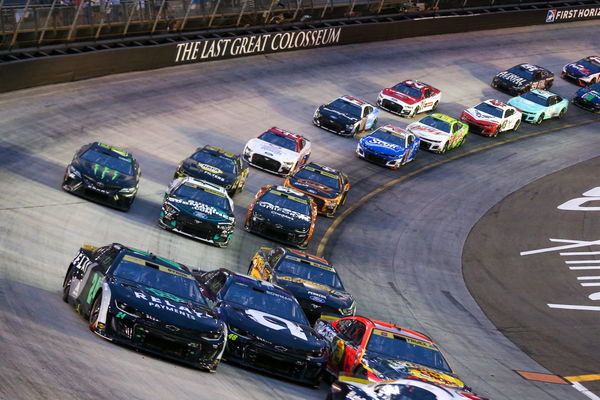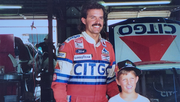
USA Today via Reuters
Sep 16, 2023; Bristol, Tennessee, USA; NASCAR Cup Series driver William Byron (24) and driver Martin Truex Jr. (19) and driver Alex Bowman (48) during the Bass Pro Shops Night Race at Bristol Motor Speedway. Mandatory Credit: Randy Sartin-USA TODAY Sports

USA Today via Reuters
Sep 16, 2023; Bristol, Tennessee, USA; NASCAR Cup Series driver William Byron (24) and driver Martin Truex Jr. (19) and driver Alex Bowman (48) during the Bass Pro Shops Night Race at Bristol Motor Speedway. Mandatory Credit: Randy Sartin-USA TODAY Sports
NASCAR has embarked on an adventurous journey with its premier offering, the Cup Series in 2025. The Autódromo Hermanos Rodríguez in Mexico City will host the first points-paying race on Sunday, June 15. This perfectly aligns with NASCAR’s long-term vision of entering new markets and attracting more race fans.
It also marks the return of NASCAR racing in Mexico after it hosted four Xfinity Series races from 2005-08. However, the governing body isn’t restricting itself from considering options to host NASCAR events on the American continent. In fact, according to Ben Kennedy, the next international event can be inside a hybrid stadium or an Olympic venue.
ADVERTISEMENT
Article continues below this ad
We might see season-opener Clash at an international venue
The Clash event has helped NASCAR enter a new territory away from the traditional setting or venues. LA Memorial Coliseum hosted the exhibition race for three years from 2022-24. Moving forward, the event will return to the historic short track at Bowman Gray in 2025. It seems like the Clash and the All-Star exhibition races are the ones that can be experimented with.
Not only that, we have seen the governing body invest in street racing in recent years. The two editions of the Chicago Street race have allowed NASCAR to consider options for hosting such an event internationally. “If you can run on the streets, then that gives you the ability to literally run anywhere that has a street on it. It’s something that we’ve talked a lot about; you know, do you potentially turn into a stadium series?” NASCAR Executive Vice President Ben Kennedy said this on the Happy Hour podcast No. 54.
Elaborating on this prospect, he added, “I think the biggest opportunity for us frankly is more so abroad. There are a ton of stadiums that you can actually build a quarter-mile racetrack inside of in the United States. But there are a ton outside, especially as you start to talk about Olympic venues and soccer stadiums and all of those sorts. So we have a deck that has hundreds of stadiums, which ones you can and can’t do.”

USA Today via Reuters
Feb 3, 2024; Los Angeles, California, USA; General view as NASCAR Cup Series driver Joey Logano (22) and driver Kyle Larson (5) lead the restart of the Busch Light Clash at Los Angeles Memorial Coliseum. Mandatory Credit: Gary A. Vasquez-USA TODAY Sports
This idea isn’t something unprecedented, as NASCAR has a history of hosting multiple exhibition events internationally. The question is, are they willing to push the boundaries further with a points race in Mexico already on the schedule?
Trending
ADVERTISEMENT
Article continues below this ad
A quick recap of NASCAR’s exhibition international events
Let’s talk stadium racing—where the roar of engines meets the thrill of tight turns, and NASCAR has ventured beyond U.S. borders to make history in some unforgettable ways. One of the earliest international leaps came in 1958 when NASCAR headed north to Canada, transforming the Canadian National Exhibition Stadium into a battleground of speed. With a 0.33-mile asphalt surface, it mirrored the famed Bowman Gray Stadium, and it was Lee Petty who claimed victory after leading 29 of the 100 laps. But here’s a fun nugget for the diehard fans: this was also the race where a young Richard Petty, the King himself, made his NASCAR debut driving the #142 car. A legend was born!
Fast forward to 1988, and NASCAR took its high-octane action across the globe—this time to Australia. Calder Park Thunderdome, with its fierce 24-degree banked corners, became the stage for a 280-lap showdown. It was the Alabama Gang’s own Neil Bonnett and Bobby Allison who stole the show, finishing 1-2 and laying the groundwork for NASCAR Australia, a division that ran strong from 1989 to 2002. This wasn’t just a race—it was a statement. NASCAR had arrived Down Under, and it was ready to dominate.
But perhaps the boldest move came in 1996 when NASCAR went to Japan for the NASCAR Thunder Special at the iconic Suzuka Circuit. This wasn’t just any race—it was a cross-continental clash, pitting drivers from Japan and Australia against NASCAR’s best. Rusty Wallace edged out Dale Earnhardt by a hair in a thrilling finish, winning the first race and etching his name into the international NASCAR history books.
ADVERTISEMENT
Article continues below this ad
When NASCAR returned to Japan in 1997, it wasn’t smooth sailing. Torrential rains threatened to derail the entire event, but from the chaos emerged a game-changing innovation: wet weather tires. Yes, NASCAR broke new ground by introducing rain tires in 1997, proving that not even Mother Nature could stop the action. Mike Skinner claimed victory, beating out Mark Martin in what became a historic race for all the right reasons.
These aren’t just footnotes in history—they’re proof that NASCAR is more than capable of taking its heart-pounding drama worldwide. And the best part? They did it all without compromising their iconic American events, keeping the core of the sport intact while expanding its reach. This is the essence of NASCAR—pushing limits, breaking barriers, and proving that speed has no borders.
ADVERTISEMENT
ADVERTISEMENT
ADVERTISEMENT
ADVERTISEMENT





